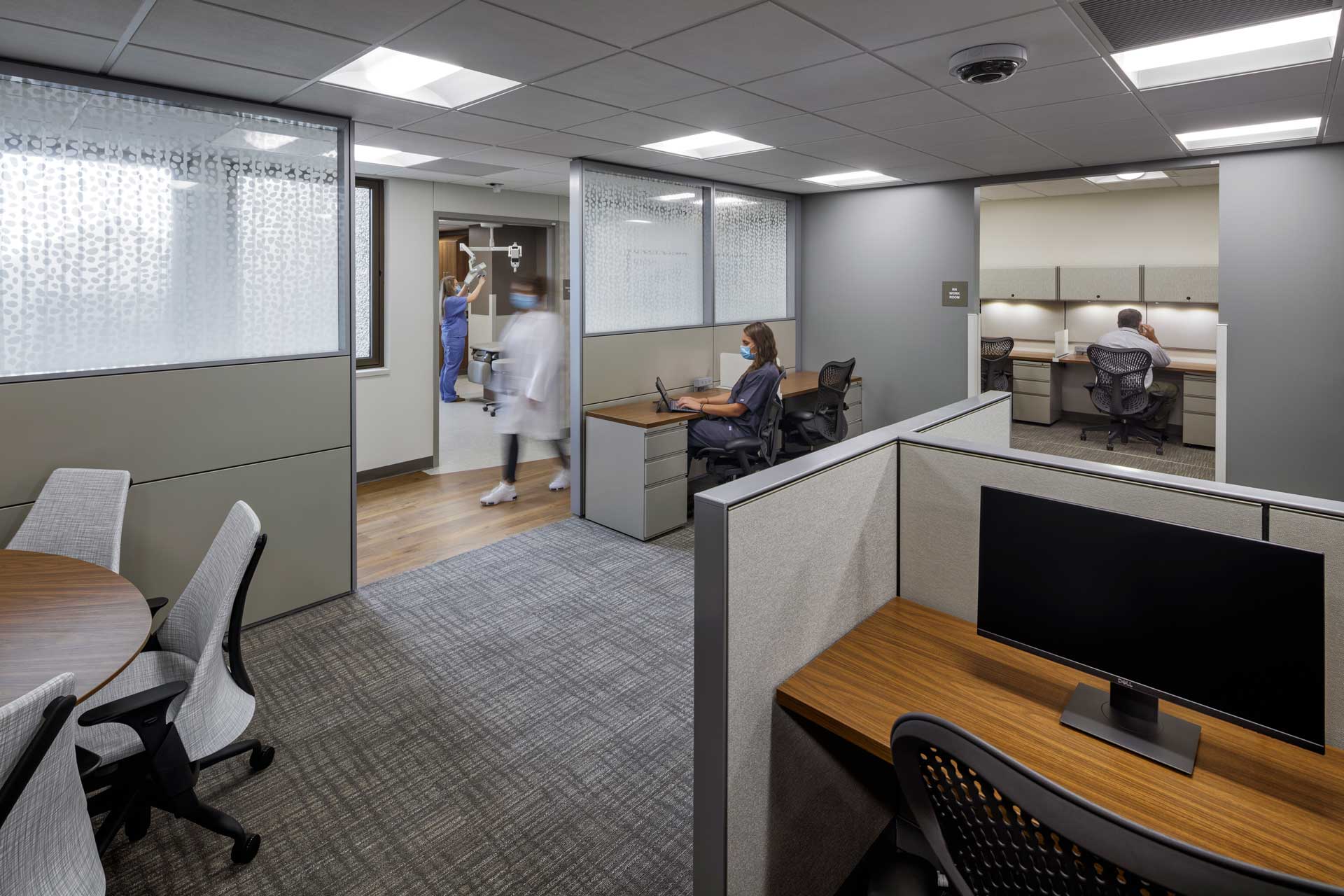Healthcare delivery is being redefined to include a team-based approach to patient care with collaboration between clinicians to develop diagnosis and treatment plans. At Zimmerman Architectural Studios, we design highly functional healthcare spaces for patients and patient care. We apply that same rigor in the design of workspaces for healthcare staff so they can deliver the best care to their patients.
We design work areas for our clients that promote coordination, collaboration and communication between team members and support the team-based model of care which “strives to meet patient needs and preferences by actively engaging patients as full participants in their care, while encouraging all health care professionals to function to the full extent of their education, certification, and experience.” Having highly effective workspaces enhances a healthcare facility’s level of patient care. As more staff return to working in person after a year of working remotely, healthcare organizations can take this time as an opportunity to analyze staff workspaces and ensure that the environment supports collaboration and team-based care.
Features of the Team Work Area
In a recent clinic renovation project for a client, we designed team work spaces where physicians, nurses, medical assistants and non-clinical team members such as interpreters and social workers are collocated in pods. The furniture layout is flexible and can be changed in the future to meet the needs of the users if the team members change. The workstations are a standard size and configuration that promotes a feeling of equality in the team. Mobile tables and shared islands are provided for quick collaboration sessions among team members.

Resources such as printers, copiers, supplies are shared in the work pods. Sharing common resources is more efficient and also helps promote spontaneous interactions between staff as they move from their desks to the shared resource area.
It is important to recognize that there is still a need to provide heads down, focused work areas and private rooms for telehealth visits, private phone calls and small group meetings. A variety of work spaces in the team work area gives team members choice and control over their working style.
Excess noise levels can become an issue in open work spaces. Acoustic control was provided in this project through the selection of interior finish materials. An acoustic ceiling tile with a high Noise Reduction Coefficient value helped absorb sound along with the use of carpet as the flooring material.
Benefits of Collaborative Work Areas
We have long seen the benefits of collaborative work areas in workplace design, now healthcare staff are experiencing the benefits as well. Working together in teams can help to improve communication, staff satisfaction and provide social connections.
Improved communication
Collaboration areas and having the team collocated in the same area helps promote more frequent communication. They can gather in small groups for collaboration and impromptu meetings.
Staff Satisfaction
A work environment that helps nurses feel like part of a care team improves job satisfaction and reduces staff turnover rates, which in turn reduces hiring costs.
Provide Social Connections
In more traditional healthcare workspace design, physicians had private offices and nurses and medical assistants worked in shared areas. Physicians were physically and socially separated from the nursing staff. With a team-based model of care, all care providers are working in the same space. Along with improved communication, staff can make stronger social connections with their team members which leads to improved performance and satisfaction.
Leveraging Technology
The impact of technology in the healthcare workspace has grown considerably in the past year. A recent study by JAMA Network Open examined changes in health services among 6.8 million commercially insured individuals in the United States during the first two months of the COVID-19 pandemic. The study revealed that “overall health care use declined by 23% in March 2020 and by 52% in April 2020 relative to existing time trends” however “observed large increases in telemedicine services of “more than 1000% in March 2020 and more than 4000% in April 2020” Telehealth visits are now part of a typical day for many providers, so providing dedicated space for that work is key. The need to provide private spaces, within team work areas, where providers can conduct telehealth visits is growing for.
Care teams also need space for small group viewing and instruction, as well as larger spaces for collaboration. As teams flex and work from various locations, the need for video conferencing ability in all work spaces has become a necessity. Throughout the past year, we as healthcare designers have seen a large shift in where and how healthcare staff work. Wireless networks and laptops allow work to be done anywhere, care providers are not restricted to a desk now.
The Future of Collaborative Workspaces
Healthcare systems are reevaluating which workers need private office space, team space or virtual work spaces. For the clinical staff who do their work in person and provide direct patient care, we see more healthcare organizations moving toward providing work spaces that support team-based care.
The benefits of team-based care, for the both care team and the patient, are clear. “A recent study of 250 primary care practices found that teams provided better care and outcomes than solo providers for patient with diabetes, hyperlipidemia, and hypertension.” As in-person patient visit volumes return and the need for team-based care increases, we are designing workspaces that respond to the type of work being done. Flexible furnishings and different work zones promote coordination, collaboration, and communication between team members to help them provide high-quality patient care.


